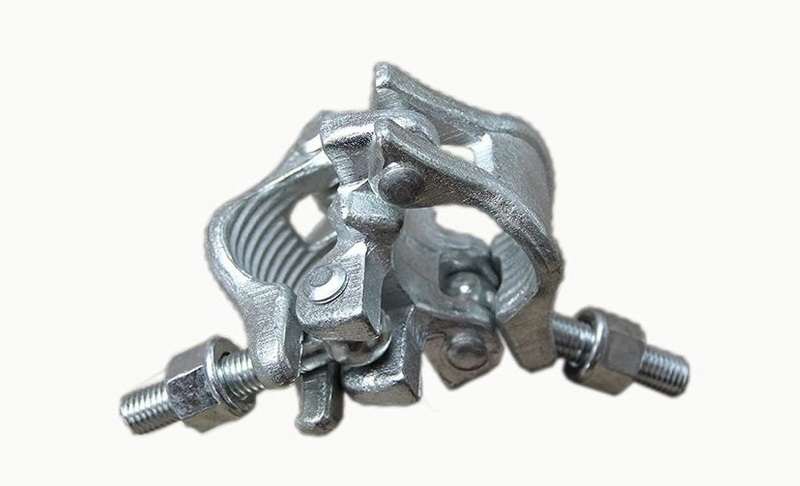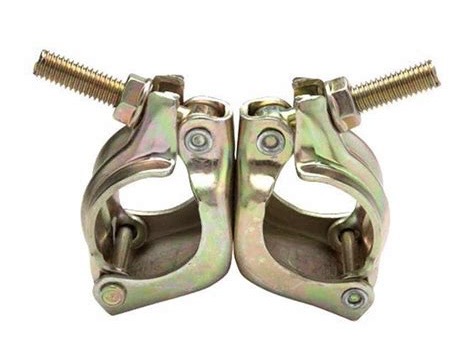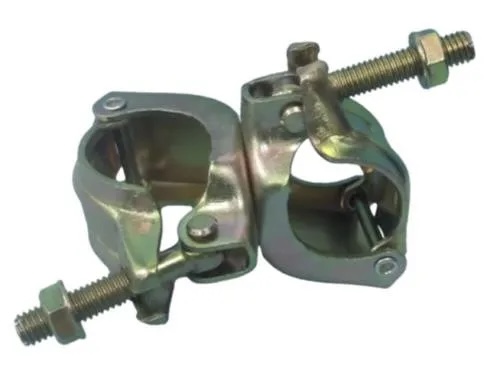Content Menu
● Key Features of Fixed Clamps
● Types of Scaffolding Systems and Clamp Compatibility
● Fixed Clamp vs. Swivel Clamp: Key Differences
● Industry Standards and Load Capacities
● Correct Applications for Fixed Clamps
● Limitations: When Not to Use Fixed Clamps
● Safety, Inspection, and Best Practices
>> Inspection and Maintenance
>> Best Practices for Using Fixed Clamps
● Advanced Tips for Using Fixed Clamps
>> 1. Ensuring Uniform Tightening
>> 2. Strategic Placement
>> 3. Mixing with Other Clamp Types
>> 4. Environmental Considerations
● Innovations and Trends in Scaffolding Clamps
● Conclusion
● FAQ
>> 1. Can I use a fixed clamp for scaffolding in modular systems like Cuplock or Ringlock?
>> 2. What is the main difference between a fixed clamp and a swivel clamp?
>> 3. How do I know if my fixed clamp for scaffolding is safe to use?
>> 4. Can I use a fixed clamp for diagonal bracing in scaffolding?
>> 5. What are the load capacities of a fixed clamp for scaffolding?
A fixed clamp for scaffolding (also called a right angle clamp or double coupler) is a mechanical fitting designed to connect two scaffold tubes at a precise 90-degree angle, creating a rigid, non-rotating joint. This connection is fundamental for building stable, load-bearing scaffold frames, especially in tube and clamp scaffolding systems.

Key Features of Fixed Clamps
- Provides a secure, non-rotating connection.
- Used for joining horizontal and vertical tubes (uprights and ledgers).
- Manufactured in forged or pressed steel, often with anti-slip and corrosion-resistant finishes.
- Compliant with international standards such as BS1139, EN 74, and JIS 8951.
- Available in various sizes to match tube diameters (typically 48.3mm OD for standard scaffolding).
Types of Scaffolding Systems and Clamp Compatibility
Not all scaffolding systems use or require the same type of clamps. Here's how the fixed clamp for scaffolding fits into different systems:
| Scaffolding System | Fixed Clamp Use | Alternative/Additional Clamps | Notes |
| Tube and Clamp | Essential | Swivel clamps, sleeve clamps | Fixed clamps form the main load-bearing joints. |
| Cuplock | Limited | Cuplock joints | System uses proprietary locking nodes; fixed clamps may be used for add-ons. |
| Ringlock | Limited | Ringlock rosettes | Modular system; fixed clamps only for special connections. |
| H-Frame/Facade | Sometimes | Board clamps, ledger clamps | Used for custom bracing or extensions. |
| Kwikstage | Rare | Wedge lock couplers | System-specific connections. |
| Suspended/Putlog | Sometimes | Putlog clamps, beam clamps | Fixed clamps may be used for bracing. |
Summary: Fixed clamps are essential in traditional tube and clamp scaffolding, but their use in modular systems like Cuplock or Ringlock is limited to special cases or custom connections.
Fixed Clamp vs. Swivel Clamp: Key Differences
Understanding the distinction between a fixed clamp for scaffolding and a swivel clamp is crucial for safe and efficient scaffold assembly.
| Feature | Fixed Clamp (Right Angle) | Swivel Clamp |
| Joint Angle | 90° only | Any angle (up to 360°) |
| Movement | Rigid, non-rotating | Allows rotation |
| Main Use | Connecting ledgers/uprights | Diagonal bracing, odd angles |
| Load Bearing | High | Moderate |
| Common Applications | Main structure, corners | Bracing, slopes, irregular shapes |
Key Points:
- Fixed clamps provide the backbone of the scaffold, ensuring rigidity and load transfer.
- Swivel clamps are used where tubes must connect at non-right angles, such as for diagonal braces or on sloped/irregular surfaces.
Industry Standards and Load Capacities
Fixed clamps are manufactured and tested according to international standards (BS1139, EN 74, JIS 8951, etc.) to ensure safety and reliability. Load capacity is a critical factor:
- Slipping Force: Class A and AA fixed clamps must resist at least 7.0KN and 10.0KN respectively.
- Failure Force: Class A clamps must withstand 20.0KN; Class AA up to 30.0KN or higher.
- Material and Finish: Hot-dip galvanized fixed clamps are preferred for durability, especially in harsh or offshore environments.
Proper installation and regular inspection are essential to maintain these load ratings and ensure safety on site.

Correct Applications for Fixed Clamps
- Tube and Clamp Scaffolding: Main horizontal (ledger) to vertical (upright) connections.
- Corners and Junctions: Where two tubes must be joined at a right angle for maximum stability.
- Load-Bearing Joints: Any structural connection that will bear significant weight or transfer loads through the scaffold.
- Custom Bracing: In modular systems, fixed clamps may be used for additional bracing or non-standard extensions.
Best Practice:
Always use fixed clamps for horizontal and vertical connections in tube and clamp scaffolding. For diagonal bracing or non-right angles, use swivel clamps instead.
Limitations: When Not to Use Fixed Clamps
Despite their versatility, a fixed clamp for scaffolding is not suitable for every application:
- Non-Right Angle Connections: Fixed clamps cannot accommodate angles other than 90°; using them in such cases can compromise scaffold integrity.
- Diagonal Bracing: Swivel clamps are required for diagonal braces or when tubes must be connected at variable angles.
- System Scaffolding: Modular systems like Cuplock or Ringlock use proprietary locking mechanisms; fixed clamps are only used for non-standard add-ons or repairs.
- Dynamic Loads or Movement: Fixed clamps are rigid—if the structure needs to flex or adapt, use the appropriate flexible connector.
Safety, Inspection, and Best Practices
Inspection and Maintenance
- Daily Checks: Inspect all fixed clamps for damage, corrosion, or improper tightening before each shift.
- Competent Person: Only a trained, competent person should inspect and approve scaffolding assemblies.
- Load Compliance: Ensure that the number and placement of fixed clamps match the scaffold's load requirements.
- Proper Tools: Use only manufacturer-recommended tools for tightening and loosening clamps.
- Replacement: Replace any clamp that shows signs of wear, deformation, or thread damage.
Best Practices for Using Fixed Clamps
- Always use fixed clamps for main structural joints at 90°.
- Never substitute a fixed clamp with a swivel clamp for load-bearing right-angle connections.
- Use hot-dip galvanized clamps for long-term or outdoor projects.
- Store clamps in a dry, organized area to prevent corrosion and mix-ups.
- Follow all local, national, and international safety standards and guidelines.
Advanced Tips for Using Fixed Clamps
1. Ensuring Uniform Tightening
For maximum safety, always use a calibrated torque wrench to tighten fixed clamps to the manufacturer's recommended torque. Over-tightening can damage the clamp or tube, while under-tightening may lead to slippage or joint failure.
2. Strategic Placement
Plan the layout of your scaffolding so that fixed clamps are positioned at all major load transfer points, especially at intersections of ledgers, standards, and transoms. This ensures the scaffold's rigidity and prevents unwanted movement.
3. Mixing with Other Clamp Types
While fixed clamps are best for right-angle joints, don't hesitate to combine them with sleeve clamps (for inline tube connections) and swivel clamps (for bracing) to optimize scaffold strength and versatility.
4. Environmental Considerations
In corrosive or marine environments, always select fixed clamps with enhanced anti-corrosion coatings. Stainless steel or hot-dip galvanized options are preferable for long-term durability.
Innovations and Trends in Scaffolding Clamps
The scaffolding industry continues to innovate, and fixed clamps are no exception. Recent advancements include:
- Quick-release fixed clamps for faster assembly and disassembly, reducing labor time.
- Integrated safety indicators that show when the clamp has been properly tightened.
- Lightweight alloy clamps that maintain strength but reduce overall scaffold weight.
- Color-coded clamps for easy identification of type and application on complex builds.
These innovations help improve both the safety and efficiency of modern scaffolding projects, making the selection and use of a fixed clamp for scaffolding even more user-friendly and reliable.
Conclusion
A fixed clamp for scaffolding is an essential component for building safe, stable, and load-bearing scaffold structures—especially in traditional tube and clamp systems. However, it is not a universal solution for all scaffolding types and applications. Fixed clamps should be used exclusively for right-angle (90°) connections between horizontal and vertical tubes, where they provide maximum rigidity and load transfer. For diagonal bracing, irregular angles, or in modular system scaffolds, alternative fittings such as swivel clamps or proprietary connectors are required.
Understanding the correct use and limitations of a fixed clamp for scaffolding is vital for site safety, compliance, and project efficiency. Always consult manufacturer guidelines, adhere to industry standards, and ensure all scaffolding assemblies are inspected by a competent person before use.

FAQ
1. Can I use a fixed clamp for scaffolding in modular systems like Cuplock or Ringlock?
No, modular systems like Cuplock and Ringlock use their own proprietary locking mechanisms. A fixed clamp for scaffolding may only be used for special add-ons or non-standard connections in these systems.
2. What is the main difference between a fixed clamp and a swivel clamp?
A fixed clamp creates a rigid, 90-degree connection between two tubes, while a swivel clamp allows for rotation and can connect tubes at any angle. Use fixed clamps for main joints and swivel clamps for diagonal bracing or irregular angles.
3. How do I know if my fixed clamp for scaffolding is safe to use?
Inspect the clamp for visible damage, corrosion, or thread wear before each use. Only use clamps that meet international standards (BS1139, EN 74, JIS 8951) and replace any that are compromised.
4. Can I use a fixed clamp for diagonal bracing in scaffolding?
No, diagonal braces require swivel clamps to accommodate the non-right angle connection. Using a fixed clamp in this application can compromise scaffold stability.
5. What are the load capacities of a fixed clamp for scaffolding?
Load capacities vary by class and standard, but a typical fixed clamp must resist slipping forces of at least 7.0KN and failure forces of 20.0KN or more. Always check manufacturer data and ensure proper installation for maximum safety.






















